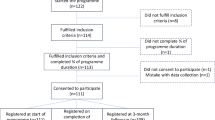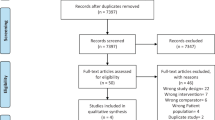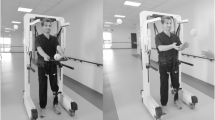Abstract
Study design
Randomized controlled trial.
Objective
To determine the effects of advanced weight-bearing mat exercises (AWMEs) with/without functional electrical stimulation (FES) of the quadriceps and gastrocnemius muscles on the ability of wheelchair-dependent people with spinal cord injury (SCI) to transfer and attain independence in activities of daily living (ADLs).
Setting
An outpatient clinic, Iran.
Methods
People with traumatic chronic paraplegia (N = 16) were randomly allocated to three groups. The exercise group (EX; N = 5) performed AWMEs of quadruped unilateral reaching and tall-kneeling for 24 weeks (3 days/week). Sessions were increased from 10 min to 54 min over the 24-week period. The exercise-FES group (EX + FES; N = 5) performed AWMEs simultaneously with FES of the quadriceps and gastrocnemius muscles. The control group performed no exercise and no FES (N = 6). The primary outcomes were the total Spinal Cord Independence Measure-III (SCIM-III) to reflect independence with ADL, and the sum of the four SCIM-III transfer items to reflect ability to transfer. There were six other outcomes.
Results
The mean (95% CI) between-group differences of the four transfer items of the SCIM-III for the EX vs. control group was 1.8 points (0.2–3.4), and for the EX + FES vs. control group was 2 points (0.4–3.6). The equivalent differences for the total SCIM-III scores were 2.7 points (−0.6–6.0) and 4.1 points (0.8–7.4), respectively. There were no significant between-group differences for any other outcomes.
Conclusions
Advanced weight-bearing mat exercises improve the ability of wheelchair-dependent people with SCI to transfer and attain independence in ADL.
Similar content being viewed by others
Log in or create a free account to read this content
Gain free access to this article, as well as selected content from this journal and more on nature.com
or
Data archiving
The datasets generated and/or analyzed during the current study are available from the corresponding author on reasonable request.
References
Scott JM, Warburton DER, Williams D, Whelan S, Krassioukov A. Challenges, concerns and common problems: physiological consequences of spinal cord injury and microgravity. Spinal Cord. 2011;49:4–16.
Rivers CS, Fallah N, Noonan VK, Whitehurst DG, Schwartz CE, Finkelstein JA, et al. Health conditions: effect on function, health-related quality of life, and life satisfaction after traumatic spinal cord injury. A prospective observational registry cohort study. Arch Phys Med Rehabil. 2018;99:443–51.
Hetz SP, Latimer AE, Ginis KA. Activities of daily living performed by individuals with SCI: relationships with physical fitness and leisure time physical activity. Spinal Cord. 2009;47:550–4.
Sezer N, Akkuş S, Uğurlu FG. Chronic complications of spinal cord injury. World J Orthop. 2015;6:24–33.
Carpenter C, Forwell SJ, Jongbloed LE, Backman CL. Community participation after spinal cord injury. Arch Phys Med Rehabil. 2007;88:427–33.
Nelson AL, Groer S, Palacios P, Mitchell D, Sabharwal S, Kirby RL, et al. Wheelchair-related falls in veterans with spinal cord injury residing in the community: a prospective cohort study. Arch Phys Med Rehabil. 2010;91:1166–73.
You JS, Kim YL, Lee SM. Effects of a standard transfer exercise program on transfer quality and activities of daily living for transfer-dependent spinal cord injury patients. J Phys Ther Sci. 2017;29:478–83.
Gagnon D, Nadeau S, Noreau L, Eng JJ, Gravel D. Trunk and upper extremity kinematics during sitting pivot transfers performed by individuals with spinal cord injury. Clin Biomech. 2008;23:279–90.
Gagnon D, Koontz AM, Brindle E, Boninger ML, Cooper RA. Does upper-limb muscular demand differ between preferred and nonpreferred sitting pivot transfer directions in individuals with a spinal cord injury? J Rehabil Res Dev. 2009;46:1099–108.
Desroches G, Gagnon D, Nadeau S, Popovic MR. Effects of sensorimotor trunk impairments on trunk and upper limb joint kinematics and kinetics during sitting pivot transfers in individuals with a spinal cord injury. Clin Biomech. 2013;28:1–9.
Milosevic M, Masani K, Kuipers MJ, Rahouni H, Verrier MC, McConville KM, et al. Trunk control impairment is responsible for postural instability during quiet sitting in individuals with cervical spinal cord injury. Clin Biomech. 2015;30:507–12.
Seong Choe H, Min DK, Ahn J. Effects of anterior weight-shifting methods on sitting balance in wheelchair-dependent patients with spinal cord injury. J Phys Ther Sci. 2018;30:393–7.
Jacobs PL. Effects of resistance and endurance training in persons with paraplegia. Med Sci Sports Exerc. 2009;41:992–7.
Paralyzed Veterans of America Consortium for Spinal Cord Medicine. Preservation of upper limb function following spinal cord injury: a clinical practice guideline for healthcare professionals. J Spinal Cord Med. 2005;28:434–70.
Tweedy SM, Beckman EM, Geraghty TJ, Theisen D, Perret C, Harvey LA, et al. Exercise and Sports Science Australia (ESSA) position statement on exercise and spinal cord injury. J Sci Med Sport. 2017;20:108–15.
Martin ST, Kessler M. Neurological intervention for physical therapy. 3rd ed. Saunders: Elsevier; 2015. p. 431–3.
Sullivan PE, Markos PD. Clinical decision making in therapeutic exercise. 1st ed. Norwalk: Appleton & Lange; 1994. p. 45. 73–75, 210
Martin R, Sadowsky C, Obst K, Meyer B, McDonald J. Functional electrical stimulation in spinal cord injury: from theory to practice. Top Spinal Cord Inj Rehabil. 2012;18:28–33.
Ho CH, Triolo RJ, Elias AL, Kilgore KL, DiMarco AF, DPhil KB, et al. Functional electrical stimulation and spinal cord injury. Phys Med Rehabil Clin N Am. 2014;25:631–54.
Gorgey AS, Lawrence J. Acute responses of functional electrical stimulation cycling on the ventilation-to-CO2 production ratio and substrate utilization after spinal cord injury. PM R. 2016;8:225–34.
Fornusek C, Davis GM, Beak I. Stimulation of shank muscles during functional electrical stimulation cycling increases ankle excursion in individuals with spinal cord injury. Arch Phys Med Rehabil. 2012;93:1930–6.
Lopes AC, Ochoa-Diaz C, Baptista R, Fonseca L, Fattal C, Azevedo Coste C, et al. Electrical stimulation to reduce the overload in upper limbs during sitting pivot transfer in paraplegic: a preliminary study. Eur J Transl Myol. 2016;26:278–82.
Jovic J, Azevedo Coste C, Fraisse P, Henkous S, Fattal C. Coordinating upper and lower body during FES-assisted transfers in persons with spinal cord injury in order to reduce arm support. Neuromodulation. 2015;18:736–43.
Ryan TE, Brizendine JT, Backus D, McCully KK. Electrically induced resistance training in individuals with motor complete spinal cord injury. Arch Phys Med Rehabil. 2013;94:2166–73.
Sadowsky CL, Hammond ER, Strohl AB, Commean PK, Eby SA, Damiano DL, et al. Lower extremity functional electrical stimulation cycling promotes physical and functional recovery in chronic spinal cord injury. J Spinal Cord Med. 2013;36:623–31.
Catz A, Itzkovich M, Tesio L, Biering-Sorensen F, Weeks C, Laramee MT, et al. A multicenter international study on the Spinal Cord Independence Measure, version III: Rasch psychometric validation. Spinal Cord. 2007;45:275–91.
Saberi H, Vosoughi F, Derakhshanrad N, Yekaninejad M, Khan ZH, Kohan AH, et al. Development of Persian version of the Spinal Cord Independence Measure III assessed by interview: a psychometric study. Spinal Cord. 2018;56:980–6.
Rice LA, Smith I, Kelleher AR, Greenwald K, Hoelmer C, Boninger ML. Impact of the clinical practice guideline for preservation of upper limb function on transfer skills of persons with acute spinal cord injury. Arch Phys Med Rehabil. 2013;94:1230–46.
Harvey LA, Lin CW, Glinsky JV, De Wolf A. The effectiveness of physical interventions for people with spinal cord injuries: a systematic review. Spinal Cord. 2009;47:184–95.
Calder A, Nunnerley J, Mulligan H, Ahmad Ali N, Kensington G, McVicar T, et al. Experiences of persons with spinal cord injury undertaking a physical activity programme as part of the SCIPA ‘full-on’ randomized controlled trial. Disabil Health J. 2018;11:267–73.
Gorgey AS. Exercise awareness and barriers after spinal cord injury. World J Orthop. 2014;5:158–62.
Krause JS, Broderick L. Patterns of recurrent pressure ulcers after spinal cord injury: identification of risk and protective factors 5 or more years after onset. Arch Phys Med Rehabil. 2004;85:1257–64.
Triolo RJ, Bailey SN, Miller ME, Lombardo LM, Audu ML. Effects of stimulating hip and trunk muscles on seated stability, posture, and reach after spinal cord injury. Arch Phys Med Rehabil. 2013;94:1766–75.
Herzog T, Swanenburg J, Hupp M, Mittaz Hager AG. Effect of indoor wheelchair curling training on trunk control of person with chronic spinal cord injury: a randomised controlled trial. Spinal Cord Ser Cases. 2018;4:26.
Gagnon DH, Roy A, Gabison S, Duclos C, Verrier MC, Nadeau S. Effects of seated postural stability and trunk and upper extremity strength on performance during manual wheelchair propulsion tests in individuals with spinal cord injury: an exploratory study. Rehabil Res Pract. 2016;2016:6842324.
Deley G, Denuziller J, Casillas JM, Babault N. One year of training with FES has impressive beneficial effects in a 36-year-old woman with spinal cord injury. J Spinal Cord Med. 2017;40:107–12.
van Hedel HJ, Curt A. Fighting for each segment: estimating the clinical value of cervical and thoracic segments in SCI. J Neurotrauma. 2006;23:1621–31.
Aidinoff E, Front L, Itzkovich M, Bluvshtein V, Gelernter I, Hart J, et al. Expected Spinal Cord Independence Measure, third version, scores for various neurological levels after complete spinal cord lesions. Spinal Cord. 2011;49:893–6.
Bélanger M, Stein RB, Wheeler GD, Gordon T, Leduc B. Electrical stimulation: can it increase muscle strength and reverse osteopenia in spinal cord injured individuals? Arch Phys Med Rehabil. 2000;81:1090–8.
Shields RK, Dudley-Javoroski S. Musculoskeletal adaptations in chronic spinal cord injury: effects of long-term soleus electrical stimulation training. Neurorehabil Neural Repair. 2007;21:169–79.
Fornusek C, Davis GM, Russold MF. Pilot study of the effect of low-cadence functional electrical stimulation cycling after spinal cord injury on thigh girth and strength. Arch Phys Med Rehabil. 2013;94:990–3.
Acknowledgements
We gratefully acknowledge all participants who participated in this study.
Funding
This project was supported by a grant from Medical Sciences Faculty of Tarbiat Modares University, Tehran, Iran.
Author information
Authors and Affiliations
Contributions
MR was responsible for designing and planning the study, data collection, analysis, and interpretation, and writing the report. GT was responsible for designing and planning the study, analysis and interpretation of the results, and revision of the manuscript critically for important intellectual content. MG contributed to the neurological and related clinical conception and design. AG-Z contributed to the conception and design. All authors read and approved the final manuscript.
Corresponding author
Ethics declarations
Conflict of interest
The authors declare that they have no conflict of interest.
Ethics
The Research Ethics Committee of Tarbiat Modares University (Tehran, Iran) approved the study protocol #52D/5326. We certify that all applicable institutional and governmental regulations concerning the ethical use of human volunteers were followed during the course of this research.
Additional information
Publisher’s note: Springer Nature remains neutral with regard to jurisdictional claims in published maps and institutional affiliations.
Rights and permissions
About this article
Cite this article
Rahimi, M., Torkaman, G., Ghabaee, M. et al. Advanced weight-bearing mat exercises combined with functional electrical stimulation to improve the ability of wheelchair-dependent people with spinal cord injury to transfer and attain independence in activities of daily living: a randomized controlled trial. Spinal Cord 58, 78–85 (2020). https://doi.org/10.1038/s41393-019-0328-7
Received:
Revised:
Accepted:
Published:
Issue date:
DOI: https://doi.org/10.1038/s41393-019-0328-7
This article is cited by
-
Efficacy of suspension exercise training in spinal cord injury: a systematic review and meta-analysis
Journal of Orthopaedic Surgery and Research (2025)
-
Neuromodulation for recovery of trunk and sitting functions following spinal cord injury: a comprehensive review of the literature
Bioelectronic Medicine (2023)
-
Prognostic impact of the cross-sectional area of the erector spinae muscle in patients with pleuroparenchymal fibroelastosis
Scientific Reports (2023)
-
Spinal cord injury: molecular mechanisms and therapeutic interventions
Signal Transduction and Targeted Therapy (2023)
-
Do any physiotherapy interventions increase spinal cord independence measure or functional independence measure scores in people with spinal cord injuries? A systematic review
Spinal Cord (2021)



